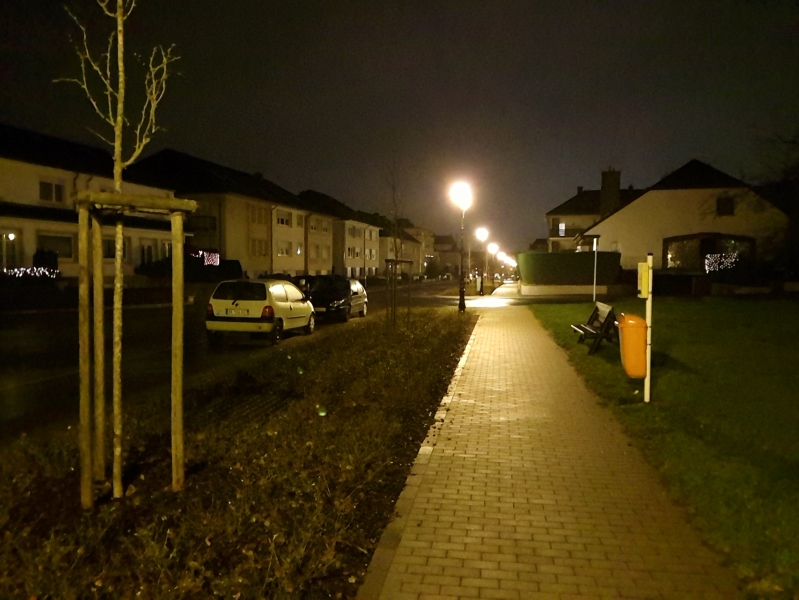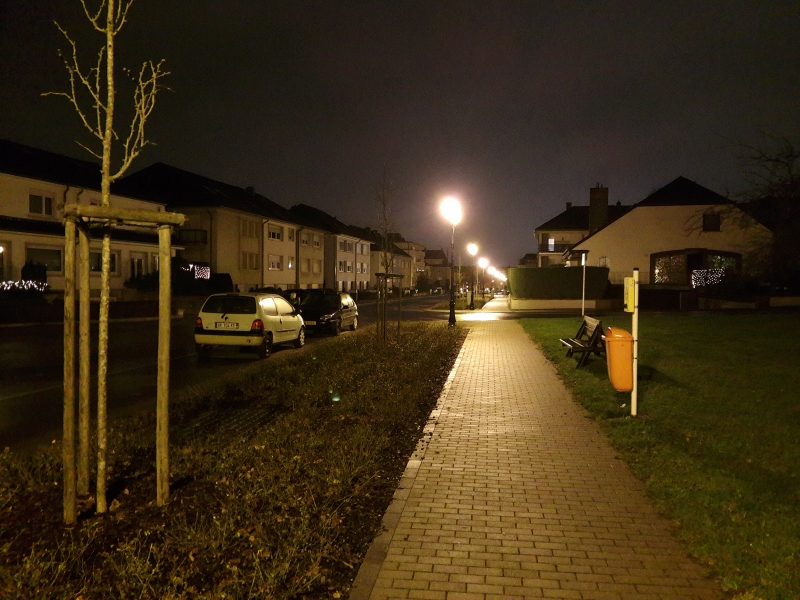The Meizu MX4 Pro Review
by Andrei Frumusanu on February 16, 2015 2:00 AM EST- Posted in
- Smartphones
- Exynos
- Mobile
- Meizu
Camera - Still Pictures
Meizu's back shooter comes with a 20.7MP Sony IMX220 camera sensor together with a F/2.2 aperture, ISP 5-piece lens main camera. The sensor is a 1/2.3" format with 1.2µm sized pixels. There is no OIS or special AF functionality in the module, which makes this a more simplistic camera to examine.
In my cloudy December months the device was able to capture a good amount of detail thanks to the 20.7MP resolution of the sensor. I did notice that the camera tends to underexpose just a tad from reality, making pictures appear darker than they should be. Auto mode shooting during the day seems to like to default to 1/50s exposure on ISO-40. There is little noise in the pictures and shooting latency is good. However, when using HDR the device struggles as taking an HDR shot can take up to 3-4 seconds. I'm not sure what's wrong here but it seems Meizu isn't employing the sensor's HDR capabilities but falls back to software or ISP processing.

Location 1:
Location 2:
The differences in post-processing are especially visible when comparing a 100% crop to the likes of the Note 4. Although the Note has OIS, the major differences are to be found in the sharpening and saturation of colors. Again here it seems that Meizu doesn't employ a companion ISP that enables such post-processing.

1/25s ISO-2000 Night shot (5MP)
When switching over to night shots there is a conundrum of choice between using a slow but otherwise excellent quality HDR mode, or to switch over to a dedicated night shot mode. In the night shot mode it seems that the sensor is employing pixel binning as maximum resolution is limited to just 5MP. The resulting picture loses a lot of detail and sharpness but capture time is excellent and allows for quick shooting in darkness.

Normal mode:
HDR:
Trying to shoot in darkness in the normal mode is a futile exercise as the camera simply isn't able to cope and will result in underexposed shots. In my everyday usage I found the night shot mode to have too great of a picture quality sacrifice due to the 1/4 resolution limitation, so HDR is the only viable alternative. The Meizu still manages to provide very good image results for a non-OIS shooter and leaves the likes of the Honor 6 and Mate 7 in the dust when it comes to night-time shooting.
Lastly the panorama function was severely disappointing, as the phone couldn't hold a steady exposure and there is obvious stitching in the resulting 14512x2464 image. There is also significant motion blur throughout the image. I panned relatively slowly when taking the panorama so such a result is disappointing.
Overall I think the still camera performance of the Meizu MX4 Pro is solid. It's possible to take excellent quality pictures in bright conditions, and shooting in the dark works provided you're willing to sacrifice resolution. While image quality is not comparable to OIS devices, the MX4 Pro outperforms every other competing device in detail and quality. The one area of concern is the slow HDR mode as the processing time is excessive and disrupts fast camera usage.
Camera - Video Recording
2160p30
Note 4 Exynos reference: [ 2160p30 ]
The MX4 Pro supports 4K video recording at 30fps. The camera produces a 32.6Mbps H.264 High Profile 5.1 video stream together with stereo 96Kbps AAC audio in an MP4 format. The image quality produced is quite good; the YouTube re-encode doesn't do it justice as a lot of detail is lost. It's the lack of OIS and any EIS in this 4K video mode that is most disappointing, as trying to capture a video while moving becomes a shaky mess. A 30 second video sample comes in at a massive 120MB. There is no limit on recording length, but it's quite possible to quickly fill up the internal storage space of the device at such a rate.
1080p30
Note 4 Exynos reference: [ 1080p30 , 1080p30+EIS , 1080p60 , 1080p60+HDR ]
When moving over to 1080p there is a sudden change in picture tone as all colors get much more saturated. What seems to be happening here is that there is actual post-processing done in the 1080p stream. I think this may be related to ISP performance not being able to cope with the 4K stream. It seems because of either this post-processing or because the sensor isn't capturing at its full resolution that there is a large and discernable loss of detail. The video stream bitrate goes down to 18Mbps in the FHD mode.
720p30
Note 4 Exynos reference: [ 720p30 , 720p30+EIS ]
At 720p there is finally some kind of EIS being enabled on the device, as the stock camera application doesn't provide any manual controls for enabling or disabling EIS. What is curious is that the video stream only drops to 16Mbps compared to 1080p's 18Mbps bitrate, making for better image quality in moving subjects. Again we're seeing a significant loss of detail and I can even start seeing chromatic aberrations on contrasted edges such as the tree branches.
720p100 Slow Motion
Meizu offers a separate camera mode that is essentially a 100fps slow motion recording mode in 720p resolution. I found it odd that the resulting video file's meta-data retains the real-time video recording length instead of the actual playback length. The above sample video contains a 20 second capture time that is stretched to a video playback time of little over 80 seconds, meaning we're recording at 4x slow motion.
The MX4 Pro's video recording capabilities remain borderline satisfactory due to the lack of a more effective EIS implementation. The 4K mode is definitely the most impressive due to the amount of detail that is being retained from the sensor, but it's hampered by storage space due to the lack of a microSD card.


























70 Comments
View All Comments
bigstrudel - Friday, February 20, 2015 - link
Google has cooperated with the NSA since day 1.Google Maps for instance was purchased from the US Govt intelligence community. Android is "secured" with SELinux, provided by the intelligence community.
Its all out there on the internet.
Wall-Swe - Wednesday, February 18, 2015 - link
US gov creates spyware that invades the firmware of HDDshttp://www.neowin.net/news/us-gov-creates-spyware-...
nevertell - Monday, February 16, 2015 - link
Anything with a SIM card has a backdoor because the spec for implementing SIM cards into devices requires the vendor to provide an API to the simcard with root privileges. The SIM card actually runs it's own code, it has it's own memory, and it's completely opaque. If you want to feel safe about your privacy, don't put sensitive data on your phone, or just don't use one.ScorpionRaY - Monday, February 16, 2015 - link
Every phone has a backdoor. The only important question is, do you really have valuable information worth NSA looking at?Valis - Monday, February 16, 2015 - link
Not my K750i that I still use. =) Awesome device.web2dot0 - Monday, February 16, 2015 - link
Come on, don't use your juvenile logic. Information which may seem unless to you can become very useful for the NSA to finding out your behavioural pattern, shopping patterns, who your friends are, what you say to your friends, places where you'll most likely be in the future.The information on its own is very useless, but if you map it out, it become very useful and highly private information.
ZhenWan - Monday, February 16, 2015 - link
Well, it's better having a backdoor in Chinese made programs than backdoors in US made programs, I rather prefer to have a company exploiting my interests than a Government-funded organisation specifically made to tap into everything I do, "For the safety of "National" Security". *Cough* NSA, *Cough* CIA, *Cough* GCHQ....theduckofdeath - Tuesday, February 17, 2015 - link
To be really cynical. The Chinese aren't breaking any laws spying on Americans, while Americans bends over and lets their government feck them in the arse every day, breaking any law they see fit.Hypocrite Americans......
sonny73n - Tuesday, February 17, 2015 - link
So true.Wall-Swe - Wednesday, February 18, 2015 - link
Did you miss the news yesterday, that basically every hard drive sold in recent years have exploits built in to the firmware that is impossible to remove, curtesy of the NSA in the US .So don't point your finger at China, when the US are the bad guys.